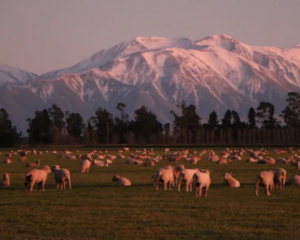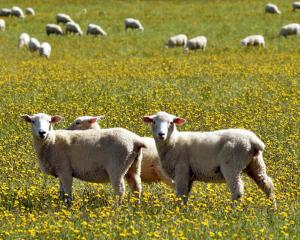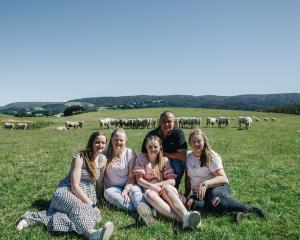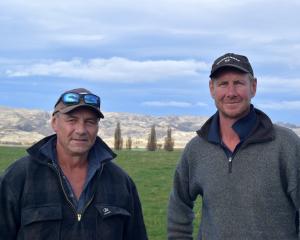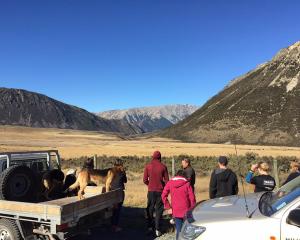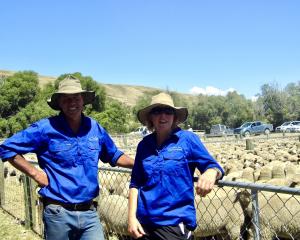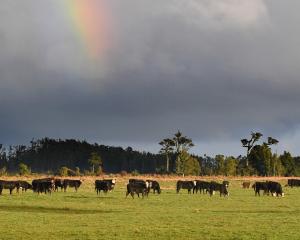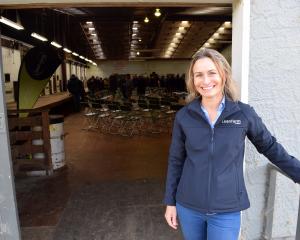National Lamb Day launches this month at the Southern Field Days at Waimumu, near Gore. Business and rural editor Sally Rae finds out more about the celebration and outlines the critical role Otago played in the development of the export meat industry.
With apologies in advance for stereotyping, it could be the makings of an Irish joke.
Did you hear the one about the Southland dairy farmer who is helping to relaunch National Lamb Day with the goal of building an annual day of celebration?
Fourth-generation dairy farmer Jon Pemberton is one of the driving forces behind AgProud NZ, set up to promote positive farming practices and raise awareness of rural people’s mental health.
Now the group is front-footing the relaunch of National Lamb Day, the date being moved to February 15 — the anniversary of the day the ship Dunedin left Port Chalmers for London in 1882 carrying the first frozen shipment of meat from New Zealand to England.
And Mr Pemberton is encouraging New Zealanders to "raise a chop to National Lamb Day" — or any New Zealand produced food for that matter.
AgProud was all about promoting the country’s food and fibre sectors in a positive light, and without any politics involved.
The lamb idea was something Mr Pemberton had been chewing over for a year or two and he approached Beef+Lamb New Zealand about shifting the date back from May.
Momentum had built from there and the initiative had garnered support from BLNZ, FMG and Port Otago.
The launch is being held at Southern Field Days, at Waimumu, February 14-16, and it was an ideal platform, he said.
On the day, there would be barbecues, echoing an initiative AgProud did back in 2019 when it hosted a winter barbecue in the centre of Invercargill to bring together both urban and rural people.
That was later rolled out to other centres and the experience showed that barriers dropped when people gathered around a barbecue.
They fed about 5000 people without any aggravation and it was a means of bringing people together, Mr Pemberton said.
New Zealanders were also encouraged to host their own family and friends for a celebration of New Zealand-produced food and an event at Parliament was also planned that week.
Inter-generational Maniototo sheep and beef farmer Emma Crutchley was initially intrigued to see images of a dairy farmer wearing a National Lamb Day T-shirt and gave Mr Pemberton a call, to say "that’s awesome".
Before she knew it, she had offered her help with the event, but like Mr Pemberton said she it was not work when it was fun.
And a lot of what had happened in the sector over the past six years had not been fun.
There was a need for a celebration, not just of lamb but all parts of the New Zealand food system.
"Everyone we’ve talked to has said ‘this is awesome, what a positive thing to do’.
"It’s kind of what we need," Ms Crutchley said.
And when it came to the challenges faced now by the industry, "if they [those responsible for the 1882 shipment] could do that then, we’ve got this, haven’t we?"
It was from Totara Estate, south of Oamaru, that the stock for that first shipment of refrigerated meat were dispatched from.
The 4311 sheep and 598 lamb carcasses on board for the 98-day journey to London made it to Smithfield Market in condition that meat workers there described as "perfect as frozen meat could be".
Only one carcass was condemned.
In a special editorial on the voyage, The Times of London described it "as a feat which must have a place in commercial — indeed in political — annals".
Then governor-general Sir David Beattie at the Totara centenary said: "In the long run, refrigeration brought prosperity.
"It helped to pay for New Zealand as we have known it, for our social order, our way of life, our security.
"All this happened because men of vision saw possibilities and made them work".
By 1892, 10 years after the Dunedin’s first voyage, 21 freezing works were in operation, exporting 2million sheep and lamb carcasses worth more than £1 million a year.

Instead, it was all in nets and slung on to the ship.
Meat exports had been critical to the port business ever since that first shipment.
About a-third of volumes was refrigerated cargo.
The advent of containerisation 50 years ago had helped all industries — but particularly the meat industry — reach out to new markets, Mr Usher said.
In June 1971, Columbus New Zealand, the first cellular container ship to leave New Zealand, sailed from Port Chalmers carrying the first containers of meat, destined for the east coast of North America, departing just a short distance from where Dunedin had sailed.
Port Otago had excellent relationships with its meat customers — its key ones being Silver Fern Farms and Alliance Group — and it was always happy to help, especially during the likes of the tricky Covid-19 period.
During his own career, Mr Usher had been fortunate to visit meat processing plants and see the process "from end to end".
Care was taken throughout the chain, from the farm through processing and again at the port where the team were passionate about "making sure things are 100%" for when the meat arrived at its destination".
Mr Usher described National Lamb Day as a "fantastic" idea.
French racks — or "lamb lollipops", as they were referred to — were a firm favourite with his children.
Ask Totara Estate property lead Jacqui Allison what she loves about her job and she enthuses "gosh, everything", describing it as "just such a magical place".
Turning off State Highway1 and coming up the tree-lined driveway, with sheep grazing in paddocks alongside, it was "just like driving into a fairy tale".
Established in the 1850s and known for its sheep, cattle and grain, the estate was bought by the New Zealand and Australian Land Company in 1866.
A downturn in wool prices during the 1870s focused the attention of New Zealand pastoralists on the results of the first shipment of frozen meat from Australia to Britain in 1880.
When that shipment proved successful, William Davidson began to organise a similar venture from New Zealand.
It was not all beer and skittles; freezing started after the meat was loaded on the ship, and five days into loading, with more than 640 sheep already frozen and more on the way from Totara, the refrigeration equipment failed.
Everything on board had to be sold in Dunedin and the shipment had to start over.
During the voyage, Dunedin’s crew noticed the cold air in the hold was not circulating, endangering the meat.
To save his cargo, the ship’s captain John Whitson crawled inside and sawed extra air holes to improve the flow of cold air.
He almost froze to death and the crew hauled him out of the freezer and resuscitated him.
Speculation followed that stress from the trip may have been partially responsible for his later death at the age of 45.
On another voyage, Dunedin sunk without trace, likely around Cape Horn.
The New Zealand and Australian Land Company sold Totara Estate in the early years of the 20th century.
The estate’s farm buildings, built of local limestone, reflected its functions — the carcass shed, stables, granary, and cookshop and quarters.
In 1980, the buildings were bought by the New Zealand Historic Places Trust (now Heritage New Zealand) with the assistance of various grants, including one from the New Zealand Meat Board.
The trust restored the buildings and created displays which illustrated the early history of Totara and the development of the frozen meat industry.
Totara Estate continued to attract an "incredible" range of visitors, all interested in its story but from very different perspectives, Ms Allison said.
Visits from school pupils illustrated how children often did not know where food came from, while a recent visit from an abattoir inspector, who was particularly interested in the carcass shed and slaughter house, revealed there were some little things that had not changed that much since that first shipment.
Ms Allison also enjoyed working for an organisation like Heritage New Zealand which "genuinely cares about these places" and prided itself in taking care of important heritage sites and ensuring their accessibility to everyone.
Coincidentally, Thomas Brydone, superintendent for the the New Zealand and Australian Land Company’s properties in New Zealand, commemorated with a monument on nearby Sebastopol Hill, oversaw the establishment of the country’s first dairy factory, at Edendale — not that far from where Mr Pemberton now farms — and ensured cheese was included with the first shipment of frozen meat.
It was understood Dunedin was the only innovation event that had measurably moved New Zealand’s GDP.


